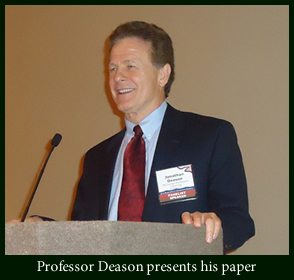EEM Lead Professor Jonathan Deason presented two papers at the Seventh International Conference on Remediation of Contaminated Sediments that was conducted in Dallas, Texas during the period February 4-7, 2013.
Civil Works-Superfund Integration: Equitable Cost Sharing for Degraded Urban Rivers
In his first presentation, Prof. Deason presented a paper co-authored with Paul Fuglevand (Principal at Dalton, Olmsted & Fuglevand, Kirkland, Washington) and Thomas Voltaggio (former Director of the Superfund Division, EPA Region III in Philadelphia, Pennsylvania).
The paper provided an overview of a cooperative project planning and development process that on eight pilots and discussed the extent to which the integration of the Water Resource Development Act (WRDA) and the Comprehensive Environmental Response, Compensation and Liability Act (CERCLA) authorities of the partnering agencies can be beneficially applied to a much larger set of rivers suffering from contaminated sediments across the nation. In addition, he provided an overview of the manner in which the integrated WRDA-CERCLA approach can lead to equitable public-private cost sharing, leading to effective and efficient solutions to the difficult challenge of restoring contaminated urban rivers.

The Urban Rivers Restoration Initiative (URRI) sprang from the Brownfields Redevelopment program in the 1990s as a way to address a major barrier (degraded urban river corridors) in some major metropolitan areas desperately needing urban renewal. The objective of the program is to replace confrontation and litigation in situations that are highly contentious with collaboration and cooperation, thereby accelerating attainment of contaminated sediment solutions. A key factor in achieving that objective involves equitable cost-sharing among various levels of government and responsible parties, a mechanism that can be achieved via the authorities provided to the Corps via WRDA and its associated Energy and Water Development Appropriations Act, in conjunction with the enforcement authorities provided to EPA via CERCLA.
The URRI is a national scale initiative combining the analytical frameworks of the Corps and EPA into to an integrated response to major rivers facing extremely challenging and potentially expensive contaminated sediment problems. While major challenges lie ahead, progress in the decade since the beginning of the URRI demonstrates that the integrated WRDA-CERCLA is viable, and that there is a great need to expand application of this concept to many more rivers throughout the United States.
Sediment Management for Urban Rivers
In his second presentation, Professor Deason described an initiative designed to break through one of the challenging aspects of urban sediment sites—a regulatory environment that does not balance remedial action requirements with the public works aspects of contaminated sediment sites in ports, harbors, and other publicly used waterways. The Urban River Restoration Initiative provides a method to link the goals of USACE authorities such as navigation, environmental dredging and ecosystem restoration with the remedial goals of the USEPA, creating a framework in which broader remediation/restoration/revitalization projects could take place.
Waterfront and river restoration/economic development projects are getting underway in cities throughout the world. In urban settings, the need for sediment remediation efforts often must be evaluated within the context of a broader set of drivers, including urban storm water and combined sewer overflow (CSO) management, green and gray infrastructure, emerging urban waterfront development, and water resources restoration goals. Decision-making and associated project objectives in urban environments are complex and usually center on political, social, and stakeholder acceptability. Furthermore, the differing timeframes for implementation of aspects of a project also can present significant challenges: remediation project designs and construction, dredged material sourcing and beneficial use, sustainability considerations, and long-term care and maintenance of the ecosystem all present project timelines that span decades, affecting present and future generations. With these complexities, proceeding to project construction within your lifetime can be a very real challenge.
Nevertheless, restoring impacted waterways and water quality is critical for economic development in urban communities and can offer significant social benefits. The regulatory environments in both the European Union and the United States suffer from competing and overlapping agency missions, and tend to focus on environmental drivers with relatively little consideration of opportunities for social, economic, and sustainability benefit. This is partially the result of regulatory systems that do not make the link between integrated sediment management, economic development, and sustainability, especially as they relate to urban systems.

Other members of Prof. Deason's panel were Todd S. Bridges (U.S. Army Corps of Engineers ERDC), Espen Eek (Norwegian Geotechnical Institute), Douglas Reid-Green (BASF Corporation) and Doug Tomchuk (U.S. EPA Region 2). The panel was co chaired by Timothy J. Dekker (LimnoTech) and Eric A. Stern (Battelle Laboratories).
Both presentations were published in A.K. Bullard and E.A. Stern (Conference Chairs), Proceedings, Seventh International Conference on Remediation of Contaminated Sediments, Dallas, Texas, February 4-7, 2013, ISBN 978-0-9819730-6-7.


